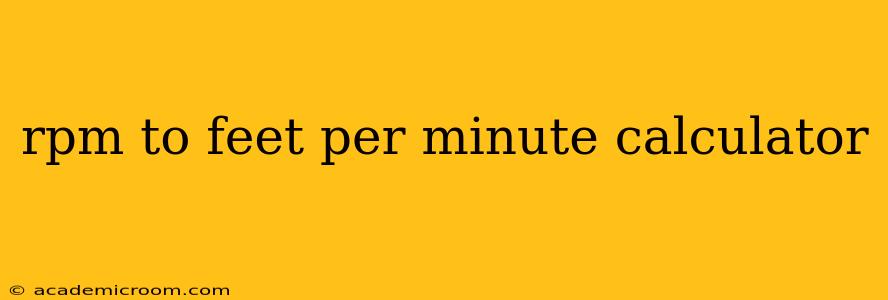Converting rotations per minute (RPM) to feet per minute (FPM) is crucial in various fields, from engineering and manufacturing to woodworking and 3D printing. Understanding this conversion is essential for calculating linear speed from rotational speed, enabling accurate estimations for machinery operation, material processing, and more. This guide will not only show you how to perform the calculation but also delve into the underlying principles and practical applications.
What is RPM?
RPM, or rotations per minute, measures how many complete rotations an object makes around a central axis in one minute. This is a common unit used to describe the rotational speed of motors, engines, wheels, and other rotating machinery.
What is FPM?
FPM, or feet per minute, measures linear speed – the distance covered in feet within one minute. In the context of RPM conversion, FPM describes the linear speed of a point on the circumference of a rotating object.
The Formula: Converting RPM to FPM
The core formula for converting RPM to FPM is:
FPM = (RPM * π * D) / 12
Where:
- RPM = Rotations per minute
- π (pi) ≈ 3.14159
- D = Diameter of the rotating object (in inches)
- 12 = Conversion factor from inches to feet
This formula takes the circumference of the rotating object (π * D) and multiplies it by the number of rotations per minute (RPM). Finally, it divides by 12 to convert the result from inches per minute to feet per minute.
Example:
Let's say a wheel with a diameter of 10 inches is rotating at 100 RPM. The calculation would be:
FPM = (100 RPM * 3.14159 * 10 inches) / 12 = 261.8 FPM (approximately)
This means a point on the circumference of the wheel is traveling at approximately 261.8 feet per minute.
How to Use an Online RPM to FPM Calculator
Many online calculators simplify this process. Simply input the RPM and diameter (in inches), and the calculator will automatically compute the FPM. These calculators offer a quick and convenient alternative to manual calculation, especially when dealing with multiple conversions. However, understanding the underlying formula is crucial for interpreting the results and troubleshooting potential errors.
Understanding the Importance of Accurate Measurements
The accuracy of your FPM calculation directly depends on the accuracy of your RPM and diameter measurements. Inaccurate measurements will lead to inaccurate FPM calculations, potentially affecting the performance of machinery or the outcome of a process. Always use calibrated instruments for measuring RPM and diameter to ensure precision.
What factors affect the RPM to FPM conversion?
The primary factors affecting the RPM to FPM conversion are the RPM itself and the diameter of the rotating object. A larger diameter will result in a higher FPM for the same RPM, and a higher RPM will yield a higher FPM for the same diameter.
How to calculate surface speed in feet per minute?
Surface speed, in the context of rotating objects, is essentially the same as FPM. The formula and calculation method remain the same as described above.
How do I convert RPM to surface feet per minute?
This is another way of phrasing the same conversion – calculating the linear speed of a point on the surface of a rotating object. The formula and procedure remain identical to the standard RPM to FPM conversion.
Applications of RPM to FPM Conversion
The conversion from RPM to FPM finds application in diverse fields:
- Manufacturing: Determining the feed rate of machine tools.
- Woodworking: Calculating the linear speed of a router bit or lathe.
- 3D Printing: Ensuring the correct extrusion speed of filament.
- Robotics: Controlling the linear movement of robotic arms.
- Automotive: Calculating the speed of a vehicle's wheels.
By mastering the RPM to FPM conversion, you gain a crucial tool for understanding and optimizing the performance of various rotating systems. Remember to always double-check your measurements and calculations for accurate results.
